|
Greek culture, especially the
city-state of Corinth, greatly influenced Etruscan art. Greek
art itself was going through what art historians refer to
as the Orientalizing period around the same time as the Etruscans.
It was in this period when Eastern influences were bringing
a new direction to art; functional objects of bronze were
decorated with monsters, animals, or flowers imitating Near
Eastern art. Stimulated by Greek imports, Etruscan artists
began to develop figural and narrative art, with sculptures
and paintings showing men or gods and a distinctly more natural
rendering of the human figure. One particular cinerary urn,
the Reclining Youth from the early fourth century
BC, is a rare bronze example of Greek influence. The stand,
decorated with stylized waves complements the generalized
austere human forms with realistic details. (ArtLex; UPenn;
Goldscheider, 6-7; 58)
Many art historians
characterize Etruscan art as less mature than contemporary
Greek art in style and execution. However, great praise is
given for the originality and imagination shown by Etruscan
art as they left their own individual, indelible imprint on
their art. To demonstrate the more literal meaning of this
statement, the bronze sculpture from second century BC, Boy
Playing with a Bird, has an inscription on his arm in
the Etruscan language. Ancient myths speak of the Chimera,
a creature that is part lion, goat, and serpent. 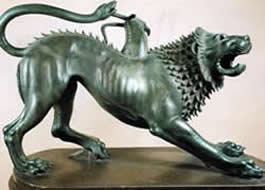 The most
savage of beasts, it sprouted fire from its mouth and devastated
the land until killed by the hero Bellerophon who flew over
it riding his winged horse Pegasus. The most renowned artistic
representation of this mythical creature is the classic statue
known as the Chimera of Arezzo, which is also one
of the most beautiful examples we have of ancient Etruscan
art. Experts have been able to decode the inscription on the
Chimera’s right foreleg to Tinia, the Etruscans’
chief god. (unifi.it; Goldscheider, 96-97; Hamblin, 33; 101-106) The most
savage of beasts, it sprouted fire from its mouth and devastated
the land until killed by the hero Bellerophon who flew over
it riding his winged horse Pegasus. The most renowned artistic
representation of this mythical creature is the classic statue
known as the Chimera of Arezzo, which is also one
of the most beautiful examples we have of ancient Etruscan
art. Experts have been able to decode the inscription on the
Chimera’s right foreleg to Tinia, the Etruscans’
chief god. (unifi.it; Goldscheider, 96-97; Hamblin, 33; 101-106)
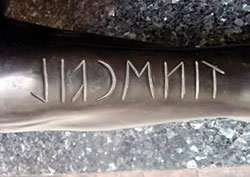
Chimera of Arezzo Inscription
|
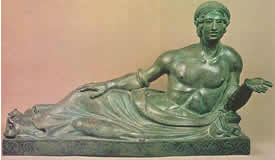
Reclining Youth
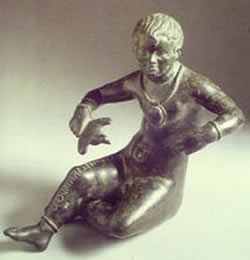
Boy Playing with a Bird
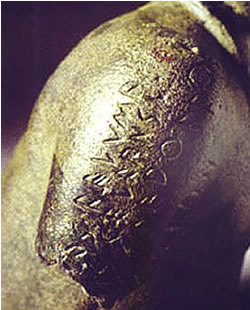
Boy Playing with a Bird
|







